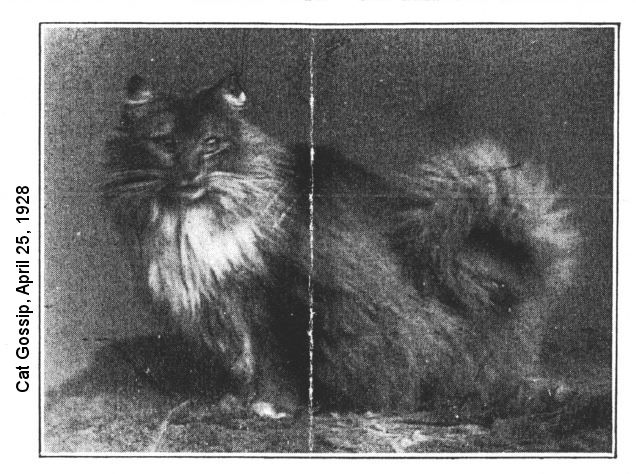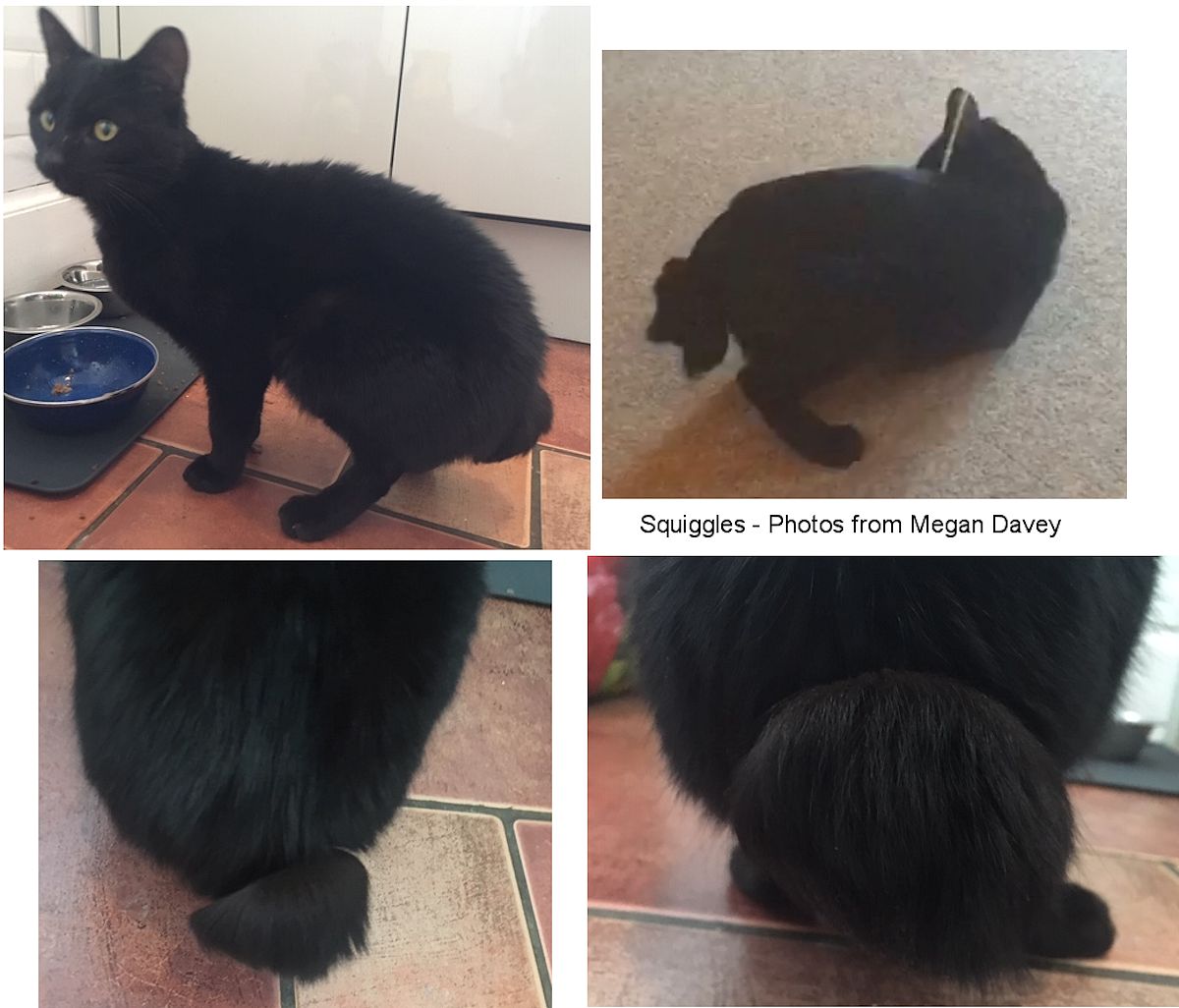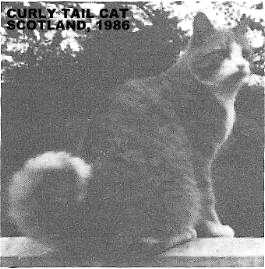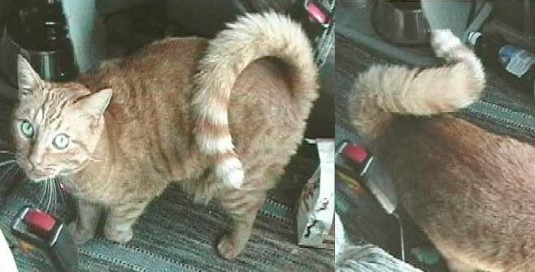
CURLY TAILED CATS
In the CAT GOSSIP column of The Ladies' Field, September 9, 1905, pg 11, "Dick Whittington" (Miss Higgins) wrote: I fail to see what is the attraction to some people in cats whose tails curl over their backs; personally, I would just as soon see a fox-terrier with a pug's tail. This deformity, for deformity it undoubtedly is, is fairly common, and I have frequently come across cats with curled tails, and have possessed several so-called "squirrel-tailed" cats, whose tails lay along their backs. The well-known smoke male, Lindfield Bogie, and a little blue queen, Scotch Mist, both had squirrel tails. Of course, such a defect, if noticed by the judge, would severely handicap a cat in the show-pen.
In the 1920s, "Cat Gossip" magazine (edited by HC Brooke) had a series of reports about curly-tailed cats. These were nicknamed "Pom cats" because their tail carriage resembled that of the popular Pomeranian dog.
In "Cat Gossip" dated 23 November 1927, Mrs. Woodhouse (Little Baddow) wrote of her "beautiful blue Persian which habitually carries her tail curved over her back, in the fashion of a pug or Chow." HC Brooke remembered thirty years previously Mrs. Stoneham used to exhibit and win with a very fine black Shorthair, Dicky Darling, which had a similar tail carriage. He added "Long before that, when the animals now known as Palm Civets were called Paradoxures, and but little known, the presence of a specimen at the Zoo with this abnormality caused some naturalists to regard it as a racial characteristic. One of Mrs. Woodhouse's cats has just produced a litter of eleven."
In "Cat Gossip" of 14th March, 1928, another curly tailed cat was described in this article by Mrs. Campbell-Fraser: "The expression "freak" invariably conveys to my mind something extremely unpleasant, from which I would willingly run away, but some days ago the photo of a pretty freak was sent me, and I christened it the Pom Cat, for he strongly resembles a dear Pom I had in days gone by, imported from Germany. Mrs. Roach-Smith, who owns Chu-Chu, lives at Sawbridgeworth, and describes him as follows: Chu is half Persian, half Abyssinian, very darkly marked down his back, inclining to tan, a most unique colour; the fur is particularly soft, and so long that in winter it nearly touches the ground. His immense fluffy tail is carried over his back. He has been mistaken for a Pom dog and for a squirrel.
Chu Chu is of a lazy disposition when about the house, and a poor mouser, but when out of doors he is quite different, and very cruel. He will wait for hours to catch birds, and climb any tree to get the nest. The villagers round about call him His Majesty, which is cute of them, for it suits him well."
I wish Mrs. Roach-Smith would ask our good Editor to print the photo of this queer cat, for with his upright bearing, his prick ears, his alertness, and the smart carriage of his brush, he might well be a specimen from the toy Pom ring at the Ladies' Kennel Club Show! Perhaps he may appear at one of our own shows next season. I am sure he would attract much attention."

This was followed by two reports in "Cat Gossip" dated 25th April, 1928: "Curly tails appear not to be so rare as one might think. Mrs. Carew-Cox writes that she had a black female which usually curled her tail over her back, but when lying down stretched it straight out. In this case the tail itself was normal, but the carriage unusual. In the case of a cat once owned by Mrs. Broughton Hawley, in which the tail was very tightly curled, forming one complete circle and very nearly a second, the tail itself must have been abnormal."
The second report read: "A CURIOUS CAT. Some weeks back Mrs. Camphell-Fraser mentioned a cat which she called a "Pom-cat," because his tail carriage gave him the appearance of a toy Pom. Cats with this peculiar carriage are recorded from time to time. (We remember a S.H. black which used to be shown by Mrs. Stoneham late in the 'nineties — Dickie Darling by name.) This cat, the property of Mrs. Roach-Smith, of Sawbridgeworth, is the son of a Persian father and an Abyssinian mother. His very long and soft coat, which touches the ground, is dark sable shading to fawn. He always carries his tail tightly curled over his hack. From an enquiry recently addressed to us by the Curator of the Exeter Zoo, we learn that there is a cat with similar tail carriage in the neighbourhood of Exmouth."
Then in "Cat Gossip" of 16th May, 1928: "The curly tail is not really very uncommon, as you justly remark! My lovely Sibo carries his in a downward curve, which is very quaint. His kink, a very small affair when he was younger, is now a well-developed curve, over and under, at the tip of his tail, and it gives the effect of a lead weight, making him carry his tail always like a crescent moon with the tip downwards! - Marion Cran."
And "Cat Gossip" of 30th May, 1928: "Re the question in a previous issue, Miss Grayton, of Yorkshire, says she formerly possessed a cat who carried her tail on her back exactly as does a squirrel — tightly right up her spine, especially so when running. As she grew out of kittenhood this cat would put her tail down occasionally, but never when in rapid motion. Thus we have heard of several cats of this "ilk," which must evidently be a freak of Nature, or a "throw back" to some unknown ancestry."
"Cat Gossip" 5th September 1928: "Again news comes to hand of yet another kitten who carries his tail "au Pom"! — flat on his back — this time it is quite a baby kit, and it will be interesting to note whether growth and maturity alters this peculiarity. The kitten in question, a pure-bred blue Persian, is in the best of health and condition, in fact, a remarkably good specimen. The position of the tail gives a very smart appearance, and it would be a curious venture to try and stabilise a breed of cats with this distinguishing feature!"
A MODERN SCIENTIFIC VIEW
In February 2019, Megan Davey, from The University of Edinburgh wrote to me about a curly tailed rescue cat her children had recently adopted. Megan is a scientist who uses naturally occurring anatomical variation to understand embryonic development in birds. "As a scientist (not a vet), I would say Squiggles belongs to a class of developmental mutants known as ‘curly tail'. The curly tail mouse model has been a model of human spina bifida for many decades, and there are also a large group of zebra fish mutants with curly tails which are often due to neural tube defects due to a loss of ‘planar cell polarity'. Basically the head end of the spinal cord develops OK but progressively becomes abnormal towards the tail as the cells which form these areas don't orientate themselves correctly. Squiggles doesn't have entirely normal leg motility either - and I think balance problems, but is happy enough but won't be breed from. As suggested on your website, many of these defects are spontaneous, not genetic. Squiggles can slightly wiggle the base of his tail, but it never unrolls."

AMERICAN RINGTAIL BREED AND AUSTRALIAN CURLY-TAIL CATS
Curly tailed cats have occurred throughout history and around the world though only recently has any interest been shown in perpetuating the trait in the form of the Ringtailed Sing-a-Ling (which became the American Ringtail in 2004). Many of the 1990s reports of curious tails confuse curly tails with bobtails. Some suggested that the cats are "longtailed bobtails" i.e. have a kinked section of tail close to the body, combined with a full-length tail with normal vertebrae beyond the kinked section; the kink would lift the tail upwards and the normal section would hang over the back or flank. In "Variation of Animals and Plants Under Domestication" Charles Darwin wrote: " I have seen a cat which always carried its tail flat on its back when pleased."
Although judges examining the early American Ringtails had reported the trait to be very rare, this is not strictly correct. Judges see pedigree cats and pedigree cats are bred for uniformity and adherence to a standard. This means rogue genes have been eliminated generations ago. The genes for curly tails would have been weeded out of pedigree lines. In addition, a curly tail would be a deviation from the standard (and might be considered a sign of genetic impurity in the breed) hence the cats would not be entered in shows, except possibly in household pet classes. It is somewhat more common in random-bred cats due to the mixed bag of genes they inherit. The trait in the American Ringtail breed was found to have variable expression and appeared to be due to two pairs of genes. One pair governed the curling of the tail and this was found to be recessive. The other pair was for the tail carriage up over the back, and this acted as an incomplete dominant. It's important to note that the cats' tails had the full normal range of motion and there were no knots, fused vertebrae or other deformities, nor was there any discomfort related to curled tails. The trait was described as purely neurological; the cats liked carrying their tails up and over when they were happy. By 2016, for various reasons, the breeding had stopped.
In November 2016, David Karamatic reported a possible new Ringtail mutation found in Adelaide, Australia. The cat, Alana, was found as a stray behind a shopping centre in Adelaide, Australia, along with her three kittens. She has a tail that resembles that of a Basenji dog. David is working to establish whether this is inheritable, and her kittens are showing signs of the ringtail trait. David is also in contact with an American Ringtail breeder as this could be the same mutation.

|
 Random-bred curly-tailed cat from Perthshire, Scotland, 1986. |
RANDOM-BRED CURLY-TAIL CATS
The trait is found with greater frequency in random breeding cats but until recently was seen as no more than a charming oddity. I was surprised to be told that the trait is so rare as I had already encountered several curly tailed cats and kittens (nicknamed pigtailed kittens) in Chelmsford, Essex, England. Their curly tails were quite distinct from the kink found in bobtails. In the Jan/Feb 1998 issue of the Cats Protection League magazine "The Cat" there is an account of further curly tailed kittens from Basildon, a town only about 13 miles from Chelmsford:- "At the time of writing, our latest little problems are four nine-week old kittens who have curly tails. Our vet has advised us that their tails are deformed and not growing properly and will have to be removed when the kittens are a little bit older. Our vets have said that once their tails are removed, they will be able to live perfectly normal lives, although they will look like little Manx cats." The report would have been written in November/December 1997 to make the Jan/Feb 1998 edition. The accompanying photo showed the kittens sitting on a cushion; their curled tails were not visible. A follow up report in a later issue merely noted that the kittens' tails had been removed and the kittens had found homes. The only other recorded case of a whole litter of curly tailed kittens was a case reported to Sue Manley (who is establishing a curly tailed breed) and was a litter born to a barn cat in Oregon.
Ida Mellen's 1940 discourse on oddities in cats included a picture of a curly tailed cat from Jenkintown, Pennsylvania. This ginger and white cat's long tail clearly forms a tight spiral. Phyllis Lauder, writing in 1981 about Shorthaired cats, noted that an ACA directive stressed that the tail shall not be carried over the back: "This last is not a common fault, but it certainly looks strange when it occurs; there is a Siamese neutered pet who carries his tail as would a Pekinese dog, and the effect is to make people laugh!" Several curly tailed cats have been reported in random-bred cats in Britain in the 1990s and early 2000s. A curly-tailed tabby and white male cat was reported in Perthshire, Scotland in 1986. The degree of curl ranges from loose through to a tight corkscrew. In one case, the tail curled at the base and for the rest of its length lay flat along the spine.
In the 1980's, Katrina Lee of Washington, DC, vacationed on the island of Guadeloupe . In a small restaurant on the lower island she saw about half a dozen various colored cats with corkscrew tails. The tails were not looped over, but stuck out from the body like a normal cat's tail while looking like they'd been wrapped around something to make them spiral! In Britain, one curly-tailed cat has achieved fame with South Ribble Pet Cat Club. Raffles is a white semi-longhair born in June 1998 and homed via a cat shelter in Oldham. When sitting, his tail forms a curl behind him. Another British curly tail is Sprocket found at Spaghetti Junction (Gravelly Hill motorway interchange in the Midlands). She was taken to Erdington Cat Rescue and it seemed that some prospective adopters didn't want her because she had a curly tail and it was perceived as a deformity or health problem.
Since the breeding programme for the American Ringtail began, reports of curly tailed cats have come in from around the world, indicating that it is not as rare as previously claimed and that there might be several different genes involved. It is now believed to be a polygenic trait i.e. several genes interact to dictate the type of curl and the degree of curling. Though the trait seems to be polygenic, some curly tailed males pass the trait onto more than 50% of the offspring while females seem to pass it on to a lesser degree. This suggests sex-linkage. There might be several different gene mutations producing a visually similar effect.
Unlike the bobtail where the vertebrae are fused into permanent kink and motion is limited, curly tailed cats have mobile tails and no fusion of vertebrae. The trait is hereditary, as a result of several interacting genes which govern the type and degree of curl, and is not a birth defect as once thought. Generally, the tail curls up and over in an arc or full circle, coming to lie against one or other flank as the cat walks. Owners of curly-tailed cats are often intrigued as to whether similar cats are "left-handed" (the tail tip on the left flank) or "right-handed". Sue Manley, breeder of American Ringtails (formerly Ringtailed Sing-a-Lings) produced another unusual tail alongside the normal ringtails. She described it as "baboon tail". The cat holds it curled up in a compete ring underneath him while he stalks around or hunts his toys. He then brings it up over his back when he is petted.
One peculiar curly tail was seen in a cat brought to a cat shelter in Chelmsford, Essex, England in 1999 or 2000. This was a black female cat whose tail curled up over her back and then lay flat along her spine. It gave her the appearance of a Rhodesian Ridgeback dog. The tail was mobile, but returned to that position when she was at rest. Over the years several "pig-tailed" kittens have turned up in the area, either as spontaneous mutations or due to genes in local feral colonies. The occurrence of several curly-tailed cats and pig-tailed kittens around the Chelmsford and Basildon areas in a six year time frame suggests a curly-tail hotspot in that part of Essex. This is most likely due to inbreeding among unneutered, free-roaming randombred cats.
Between 2000 and 2002 there were intermittent reports of curly-tailed cats and also of people seeking curly-tailed cats as companions for, to replace, an earlier curly-tailed cat. Most reports came from the USA (sadly from unidentified locations). These included a grey tabby female with a curly tail, and a grey shorthair female with a tail that curled over to rest on her back. The latter cat's tail was described as spring-loaded, quickly returning to its curled position if the tail is straightened by hand during petting. This led to a suggestion that the trait was associated with grey cats.
 >
>
A red tabby male from Missouri was reported to have a cute pigtail generally held curled up and over his back in a large perfect loop. His littermates had normal tails. His tail sometimes unwound to lie flat on his back or was held in a more conventional unwound posture during play. As the cat aged, the tail was held curled more often, suggesting a gradual loss of flexibility. The owner stressed that this caused the cat no discomfort. A cream tabby female developed her curly tail relatively late in life. She apparently had a near normal tail until she reached 8 or 9 months old, after which it became progressively more curled, forming an up-and-over curl with the tip resting on her left flank. This again suggested a loss of flexibility as the cat aged.
The majority of curly-tailed cats are random-bred cats since purebred cats have necessarily lost a degree of genetic diversity in order to produce consistent conformation. In 1997/98 a curly-tailed Turkish Van was reported. A Singapura with an unusual tail was reported in 2002. The tail was described as very flexible and he could curl it round. It is not like American Ringtails, as it does not curl as much, nor does it curl up and over. It is held low and curled in a loop at his side. An American Keuda with a similar tail ("Curlietail") was reported at around the same time. She double curled the tail when she sat down, but at 5 months old she does not curl it as much. Again, it would appear that flexibility is lost as the cat matures. Since the establishment of a breeding programme, it seems that curly tails of varying degrees are more frequent that initially suspected. What was once seen as a fault now has a serious following. Curled tails have also turned up in Russian Blues, Siamese/Orientals, Ocicats, Persians, Ragdolls, Scottish Fold, Devon Rex and Bengals (interestingly, several of those breeds have Siamese blood in their ancestry). Some Sphynx cats have the habit of curling their tail into a flat spiral when resting.
 >
>
The photos above, very clearly showing the curly tail trait, are of Barbara Clark's 4 year old curly-tailed cat "Bunzy". His brother has a normal straight tail. Bunzy and his brother were adopted from a cat shelter in Utah, USA at 8 weeks old so nothing is known of their family history. Bunzy's tail clearly loops over to rest on his left flank with the tail tip pointing outwards. A gallery of curly-tailed cats sent in by visitors to Messybeast can be seen at Curly Tailed Cats (a separate page has been created to improve loading times).
WHITE RINGTAIL
It should be noted that historical reports of the "White Ringtail" cat refer to the Turkish Van with its ringed or banded tail, not to a race of curly tailed cats. Some early mentions of curly tailed cats will have referred to the bobtailed cats common in parts of Asia. Also, very obese cats may hold their tails in a curled tail position for the simple fact that rolls of fat at the base of the tail prevent it from reaching any point below horizontal.